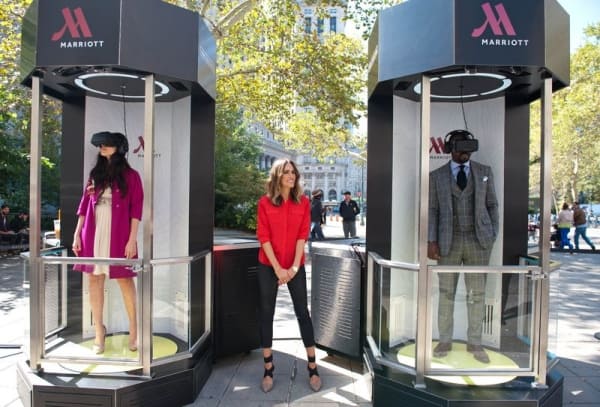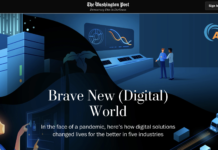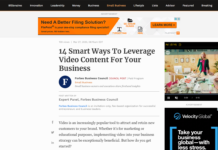Smart wearables and sensor-laden devices (SLDs) have the potential to raise brand engagement to new heights. Wearables are not simply another extension of your social media strategy but can handle something that smartphones cannot, namely a constant interaction between the computer and user that enables ambient intelligence, ubiquitous computing and biometric data tracking. This creates a unique opportunity for brands to participate in an entirely new dimension of brand engagement through wearables.
Innovate to Lead
Convey to your customers that you’re in touch with new innovative ways to engage them. Be early in your category to develop a wearable app to enhance your brand prestige. ESPN, New York Times, CNN and Fidelity chose to take a leadership position by introducing their brands on smartglasses and smartwatches. ESPN’s Google Glass app displays game scores. The New York Times Glass app and CNN’s app for Samsung Galaxy Gear give breaking news. Fidelity Market Monitor for Glass provides daily market quotes for four major stock market indices.
Engage Consumers in New Innovative Ways
Esurance, the tech-savvy, direct-to-consumer insurance company, offered an interesting wearable experience through the use of a SLD coined SavorBand for the attendees of the Food Network South Beach Wine & Food Festival, presented by Food & Wine. The SLD wristband digitally captured and stored the foods that they tasted at the festival. After the event, the brand is reinforced when the attendees log unto their Digital Memory Bank on Esurance’s website for recipes, tips from the chef, discounts and more.
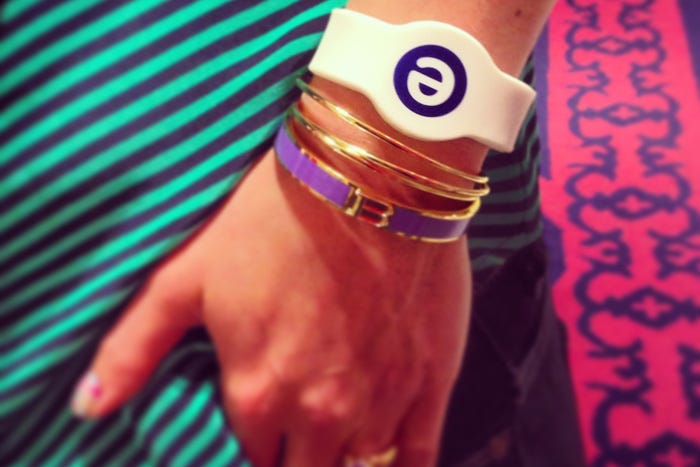
Explore New Possibilities
Delight your customers and surprise your competitors by creating new-to-the-world experiences only possible on wearable devices. Experiment with compelling use cases for the wearable computing context.
Take for instance Word Lens for Glass that let’s you see the world in your language. From road signs to menus, Word Lens for Glass lets you translate printed words from one language to another. Imagine your outdoor adverting assets from billboards, digital screens and bus shelters to airports and shopping malls around the globe being recognized and understood by international travelers.
Some innovation comes in the form of improved customer service. Virgin Atlantic started piloting Google Glass to check in its premium-class passengers; verify the details of the passenger’s flight, passport information, frequent flier status and customs and immigration information.
The Container Store is leading the adoption of wearables in retail with the hands-free Theatro Wearable Computer for their retail staff to improve voice communication over Wi-Fi within its stores.
Go Where Your Audience Hangs Out
Social network giants Facebook, Twitter, WhatsApp, Path, and Instagram are on Google Glass and/or on Samsung Galaxy Gear. These platforms are ripe to target ultra-trendsetters using (or soon to don) wearables to promote your brand. Using natural speech “Ok, Google” or a flick on the smartwatch, these early adopters can share photos, videos and messages about your brand to their legions of followers.
Absolut Vodka recognizing the footprint of WhatsApp (recently acquired by Facebook for $19 billion, with 450 million monthly active users), organized an exclusive party via WhatsApp. Absolut created “Sven” as the doorman who would choose who would win tickets to the party. Fans had to contact Sven via WhatsApp, which generated more than 1,000 video and audio messages to convince Sven to give them a ticket. The Absolut WhatsApp campaign hints at the unlimited possibilities to integrate your marketing campaigns into social platforms on wearables to reach and engage your audience.
Leverage Contextual, Ambient Intelligence to Maximize Brand Interaction
Wearables present unprecedented contextual awareness of your customers and their needs. Without distracting their goal-oriented behavior, subtle wearable cues can present helpful brand information at the right time, in the right context welcomed by the wearer.
Mercedes-Benz Digital DriveStyle app for the Pebble, for instance, offers drivers quick look at their wrists to get vehicle data, road hazards, and speed notifications. GlassTesla lets Tesla Model S owners to interact with their vehicle via Google Glass to check the charging status, locate the car, set the temperature and close and open doors remotely.
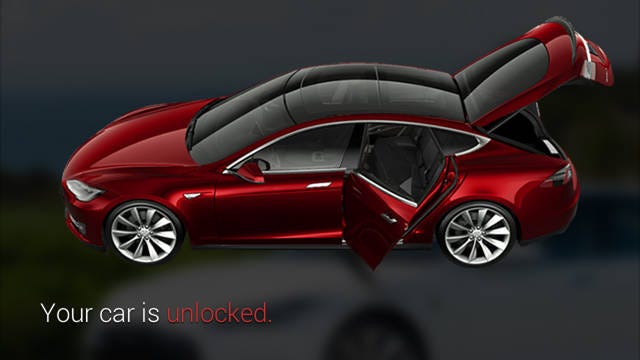
The DriveSafe Google Glass app alerts the driver when it detects that the driver is falling asleep at the wheel. Imagine a Glass notification that a 24-hour MacDonald’s that serves fresh coffee is four miles away.
Other SLDs such as the Kiwi Move, touted as an all-purpose tracking device, recognizes that you have left the office after 7pm and opens up Yelp to suggest restaurants based on your preference. Or perhaps you’re shopping at Krogers or Albertsons, wearing the augmented reality smartglasses Lumus. It projects in-store coupons based on the isle that you’re in.
Knowing your GPS location and intention, smart wearable apps can proactively suggest promotions and helpful information that reinforce your brand.
Make Your Brand Accessible Anywhere, Anytime
It’s not an exaggeration to say that consumers love convenience. Wearables take convenience to another level with with eBay Samsung Galaxy Gear app and Amazon VoiceBuyer Google Glass app that make shopping on the go a cinch. Shoppers can browse products, add to cart for later checkout on a smartphone, add items to watch lists, check the status of their bid or sale, and receive seller buyer notifications.
Fashion Discovery Labs has developed a Google Glass app that allows you to take a picture of an outfit, shoes, purse or an accessory that someone is wearing. Using image recognition technology, the wearable app then finds similar fashion items and displays the top three results. You can purchase immediately or add to your wish list. This app is a great platform for fashion brands like Armani, Ralph Lauren, Giorgio Armani, Michael Kors, Calvin Klein, Tommy Hilfiger, Kate Spade, Steve Madden and other exclusive brands to integrate with the service for faster search results and special deals for app users.

Create Fun Ways to Engage Your Brand
Ajinomoto General Foods (AGF) incorporated a humorous mustache-shaped wearable taste enhancer called the Higerable Device into their promotional campaign for its espresso drink TRIPLESSO. The “triple your enjoyment” campaign also integrated with their fun website – The Triple Times to share fun items to enhance their drinking experience.

FirstBank’s recent ad poking fun at wearables is incredibly amusing. A distracted family, each wearing Google Glass-like smartglasses, interacts with the device during dinner time as they try to eliminate pop-up ads and post content on social media.
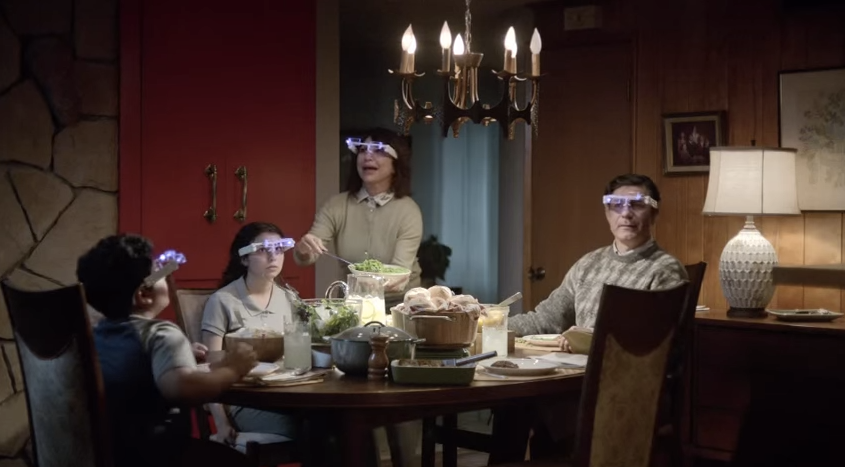
Gamification of wearables is the next frontier for brands to heighten engagement. Take for example Mind Pirate’s Google Glass 3-D action game Global Food Fight. As the name indicates, the app allows gamers to throw fruits, desserts and other virtual edibles at their opponents. Imagine Kraft Foods or General Mills sponsoring a virtual, pie-throwing contest with the option to make your own pies using their ingredients.
Google and ELLE have come up with fun ways to amuse and entertain their users. Google’s Glass Mini Games include the Balance, Clay shooter, Matcher, Shape Splitter, and Tennis.ELLE displays news on hottest fashion and culture, plus daily horoscopes.
Measure and Adjust Your Campaigns Real-Time
Smart wearables and SLDs provides something that traditional mobile computing devices cannot – biometrics. Real-time, actionable analytics give you insights into how your audience is engaging your brand and dynamically adjust to optimize their experience.
Event sponsors such as Coca Cola can utilize the crowd data to analyze audience engagement at live concerts. Lightwave bracelets are being used to collect and visualize analytics around live events for performers and artists. The wearable wristband measures the concert goer’s movement, audio levels, and temperature to provide real-time feedback to live performers to customize the event experience.

Another data-driven wearable app is the Jawbone’s Up Coffee that tracks your caffeine consumption. When used over a period of time, it will compare the data with your sleep patterns and try to tell you whether those lattes are impacting your sleep. Armed with this information, brands like Starbuck’s Tazo can suggest caffeine-free, herbal teas on the app once the daily caffeine intake has been reached.
Fitness apps such as Strava, RunKeeper, Nike’s Move, and Fitbit record running, walking, cycling, and even yoga movements. Athletic retail brands such as Athleta, Under Armour, and Lululemon can partner with these apps to unlock special deals when a personal goal is reached.
Diversify Your Presence Across Multiple Platforms and Devices
The pace at which the inchoate wearable market is evolving is at near break-neck speed. The wearables market will, for the foreseeable future, continue to be highly fragmented with no clear dominant leadership. Tech giants are muscling in with their proprietary wearable operating systems (OS) to create an ecosystem around their platforms. Google recently launched its Android Wear SDK. Samsung beat Google to the punch with its Tizen for Wearables. It’s only a matter of time before Apple introduces an extension of iOS for wearables. Jawbone is another credible contender competing to build an ecosystem around their platform. These platforms and developers hold the key to developing must-have apps for mainstream adoption and ubiquity. Given the heterogeneous landscape, compounded by ever-growing numbers of SLD hardware, it’s prudent for brands to have a presence in different wearable OS platforms and devices, while keeping your app development agile and iterative.
Industries that will be disrupted by wearables, such as retail, CPG, ecommerce, media, gaming, auto, fitness, sports and entertainment should take a cue from brands like Amazon, ESPN and Tesla and experiment with wearables now.
Originally published on Wired on April 25, 2014. Author Scott Amyx.


